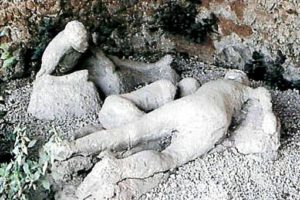What was the cause of death of the inhabitants of Pompeii?


One cannot help but wonder what caused the apparently sudden death of the Pompeiians, famously captured in lifelike positions by a technique of injecting plaster, and later plastic, into cavities which were formed by the presence of bodies under the volcanic ash.
It is tempting to speculate that there could have been time to flee, given that the August eruption lasted over a 48-hour period. Even more puzzling is the evidence that there could have been a second eruption of November 23, 79 A.D., given that seasonal clothing and produce were found to match a November type of weather.
Source:Wikipedia on Pompeii.
The below article by National Geographic explains the new theory, advanced in 2010, of how residents of Pompeii reacted to the eruption initially, and by what means they were overcome.
The famous lifelike poses of many victims at Pompeii—seated with face in hands, crawling, kneeling on a mother’s lap—are helping to lead scientists toward a new interpretation of how these ancient Romans died in the A.D. 79 eruptions of Italy’s Mount Vesuvius.
Until now it’s been widely assumed that most of the victims were asphyxiated by volcanic ash and gas. But a recent study says most died instantly of extreme heat, with many casualties shocked into a sort of instant rigor mortis.
Volcanologist Giuseppe Mastrolorenzo and colleagues began by analyzing layers of buried volcanic ash and rock, then fed the data into a computer simulation of the Mount Vesuvius eruption.
They concluded that the volcano, some six miles (ten kilometers) from Pompeii, produced six different pyroclastic surges—fast-moving, ground-hugging waves of hot, toxic gases and ash (aerial picture of Pompeii ruins).
Most of the hundreds of fatalities occurred during the fourth surge—the first to reach Pompeii—even though that surge was relatively slow and ash-poor.
Ash-deposit analysis and computer simulations of the surges suggest that Pompeii was at the edge of the flows’ reach. That would mean the fourth surge “was too weak to wreck buildings,” Mastrolorenzo, of the Italian National Institute for Geophysics and Volcanology, told National Geographic News.
The surge also carried relatively little ash, leaving behind a sediment layer only about an inch (three centimeters) deep, previous sediment measurements have shown.
But during the surge “temperatures outdoors—and indoors—rose up to 300̊C [570̊F] and more, enough to kill hundreds of people in a fraction of a second,” said Mastrolorenzo, who led the study, published in the June 2010 issue of the journal PLoS ONE.
Among the evidence for such fatal temperatures are the team’s bone studies. In a lab the researchers heated bone samples of freshly dead modern-day humans and horses, then compared the results to those seen in bones of Pompeiian victims of Vesuvius. Specific patterns of color and cracking in the ancient bones, among other features, “proved they were exposed to extreme heat,” he said.
To see the rest of this article, please visit New account of how Pompeiians died.




Isobel
Sep 19. 2015
Really helped for my homework! Really good website, thanks!
science15
Sep 23. 2015
Thanks for commenting. Glad it helped.
Jennifer
Apr 15. 2019
Remains of a horse that was killed while wearing its harness during the 79 AD eruption of Mount Vesuvius have been discovered by archaeologists.